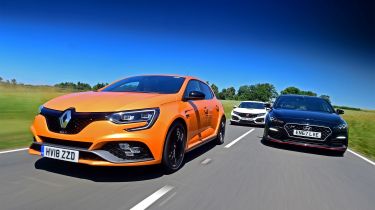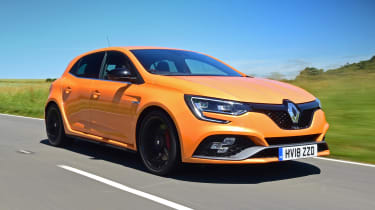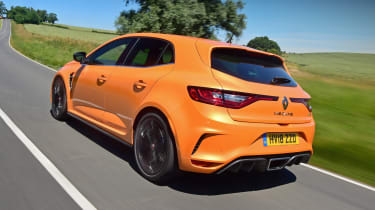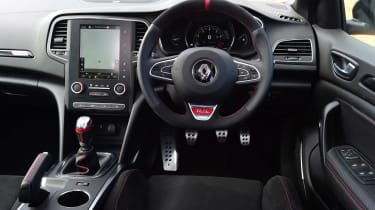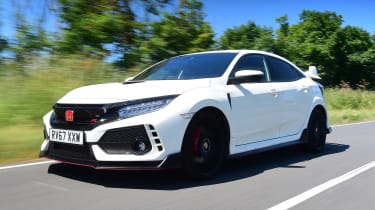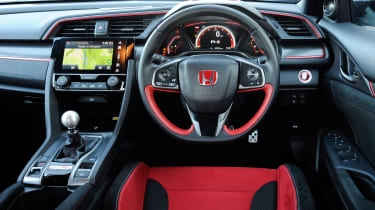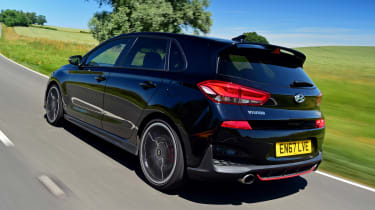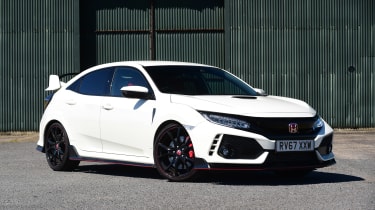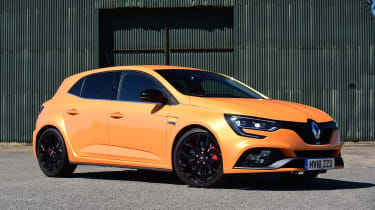Renault Megane R.S. vs Honda Civic Type R vs Hyundai i30 N
The new Renault Megane R.S. slugs it out with Honda Civic Type R and Hyundai i30 N for hot hatch glory
Renault has a rich history with hot hatches. The last two generations of Megane were benchmarks for performance, with the firm’s Renault Sport division creating cars that prioritised driver involvement.
After a hiatus there’s now a new Megane R.S., but while it’s not been on sale, a wealth of competitors have arrived. The Honda Civic Type R took the Best Hot Hatchback trophy at our New Car Awards and is fresh from a win against the VW Golf R Performance pack, but the R.S. is already here to challenge it.
As if the Renault doesn’t face a tough enough task, it will also have to rise to the challenge from the new kid on the block, Hyundai’s i30 N – in Performance trim here. Both these cars cost a similar amount and offer a similar power output to the latest Megane R.S.
So has there been a changing of the hot hatch guard, or does the Renault return to top spot when compared with its rivals from Honda and Hyundai?
Renault Megane R.S.
| Model: | Renault Megane R.S.280 Cup Chassis |
| Price: | £28,995 |
| Engine: | 1.8-litre 4cyl turbo, 276bhp |
| 0-60mph: | 6.1 seconds |
| Test economy: | 29.6mpg/6.5mpl |
| CO2: | 161g/km |
| Annual road tax: | £140 |
This Megane is the most sophisticated yet to emerge from Renault Sport’s Dieppe base in France, but is that enough to take victory here? It’s priced well, with this Cup chassis model costing from £28,995, but it’ll take more than affordability to beat the competition here. Let’s see how it fares.
Used - available now

2023 Ford
Kuga
21,659 milesAutomaticPetrol2.5L
Cash £21,697
2023 Skoda
Kamiq
17,635 milesManualPetrol1.5L
Cash £15,197
2021 MINI
Cooper Electric
24,423 milesAutomaticElectric
Cash £12,697
2017 Nissan
Qashqai
34,380 milesManualPetrol1.2L
Cash £10,697Despite its slight power deficit, the Megane recorded strong straight-line performance in our track tests, sprinting from 0-60mph in 6.1 seconds. Traction off the line is strong thanks to that diff, but the Renault’s engine feels a little flat, and in Race mode the synthesised drone isn’t that appealing. The shortage of torque showed in gear, where it trailed the Civic.
But hot hatches like these are not all about acceleration. The best have to offer a chassis that rewards; and the Renault does. It doesn’t reveal its personality straight away; you have to push the car harder for it to highlight its deftness.
There’s plenty of grip, with weighty steering that offers a nice connection. In Race mode, the four-wheel steering turns the rear wheels in the opposite direction to the fronts at up to 62mph to improve agility, and you can definitely feel it.
But there are some inconsistencies to the way it works. Going into tight turns on the brakes, helping to turn in, the system sometimes doesn’t respond how you would expect (see Testers’ notes, below).
The damping works beautifully, though, and those hydraulic bump stops are a big factor. There’s plenty of control, which means good feedback from the chassis and, therefore, predictability. On really bumpy roads at high speeds, when there’s lots of energy being put into the suspension and the dampers are near the end of their travel, the hydraulic cushions mean the Megane stays controlled and composed.
This is what elevates the R.S. from a capable hot hatch to a good one, but the six-speed manual’s shift action – notchy and not so slick – holds it back, so questions remain over whether it’s a great one.
Testers’ notes: “4Control sometimes feels as if it adds lots of agility. But sometimes it feels passive and doesn’t offer the same results, despite using just a subtly different driving style. It adds unnecessary complexity.”
Honda Civic Type R
| Model: | Honda Civic Type R GT |
| Price: | £33,525 |
| Engine: | 2.0-litre 4cyl turbo, 316bhp |
| 0-60mph: | 5.9 seconds |
| Test economy: | 31.2mpg/6.7mpl |
| CO2: | 176g/km |
| Annual road tax: | £140 |
The Honda Civic Type R picked up the Best Hot Hatchback crown for the second year in a row at our New Car Awards recently. But the appetite for these cars is highlighted by the new Megane R.S., so can the Civic fight off yet another contender? We test it in £33,525 GT trim to find out.
There’s a huge level of performance on offer in the Type R. Its 400Nm of torque is the most here, on top of which it’s the lightest car here, so it was the most convincing performer at our test track.
Strong traction off the line thanks to that diff meant a 5.9-second 0-60mph sprint. In the taller gears between 50 and 70mph the Honda also held a four tenths advantage over the Renault, partly due to its shorter gearing, pulling 2,600rpm in sixth.
The gearbox is another big advantage for the Civic. It has the best shift action and doesn’t have the slightly obstructive feel of the Renault’s. Instead, it is open and mechanically detailed, which lets you shift quickly and with precision. The engine is strong, with huge punch low down, but for a turbo it revs hard all the way towards its red line.
The chassis is easily the equal of the drivetrain; it serves up a colossal level of grip. In Sport mode, the set-up is just right for typically torn British B-roads.
It controls the body with enough restraint that it doesn’t become unruly, like the Hyundai. Even in the +R setting it’s acceptable, cornering with less roll. Still it’s best on smoother surfaces or the track, because bigger mid-corner bumps can upset the chassis.
By contrast, the compliance in Comfort mode makes the Civic genuinely usable; much more so than its predecessor or its rivals here. It’s forgiving and rides as well as some family hatchbacks, with a plush, controlled feel to the damping.
Testers’ notes: “Looks can be deceiving. Despite the Civic’s hardcore styling, which is bound to split opinion, it’s the most usable, easy to live with and comfortable car of the three, thanks to its supple suspension.”
Hyundai i30 N
| Model: | Hyundai i30 N Performance |
| Price: | £28,010 |
| Engine: | 2.0-litre 4cyl turbo, 271bhp |
| 0-60mph: | 6.7 seconds |
| Test economy: | 29.4mpg/6.5mpl |
| CO2: | 163g/km |
| Annual road tax: | £140 |
The Hyundai i30 N hot hatch arrived on the scene to great fanfare last year. It upset the establishment and landed some thudding blows on its rivals. Not least for price. We’re testing the i30 N Performance model here, which starts from £28,010.
On first impressions the i30 N is the most obviously aggressive car here. Start it up and in the exhaust’s loudest mode the engine blares into life before settling into an angry burble from its twin tailpipes. It sounds like a rally car.
This aggression continues on the move. In the suspension’s softest mode the i30 still feels stiff and unyielding. Over the same roads in the Hyundai you feel more vertical movement in the driver’s seat as your body is thrown more aggressively by bumps.
It doesn’t feel quite as settled as the Renault or as composed as the Honda. Stepping up to the stiffest mode should really be reserved for super-smooth tarmac or race tracks; more so than in the Civic.
As a result, the i30 isn’t as comfortable as its rivals, but nor does it inspire as much confidence because you have to make multiple small corrections to the weighty steering – which gives a nice, solid feel, even if it doesn’t offer as much feedback as the other two – to keep the car in check at higher speeds. Even though the diff isn’t as effective as either unit fitted to its competitors, traction is still okay and as long as you’re slow into and fast out of turns, the N romps on down the straights.
That engine has an effervescent character, the noise adding to the raucously fun feel. It revs sweetly and has a nicer gearchange than the Renault’s; it’s more precise, but can’t match the Honda’s delicious shift.
Performance is not in question. Despite being heavier and down on power, the i30 N still sprinted from 0-60mph in 6.7 seconds at the track. It was two tenths faster than the Renault from 30 to 70mph through the gears, highlighting its sweeter shift.
The Hyundai actually matched or bettered the R.S. in gear, too. Its 378Nm of torque on overboost comes in at 1,750rpm, much lower than the Renault’s top figure, which explains why the i30 had stronger pull.
Testers’ notes: “N Stands for Nürburgring and Namyang, where the i30 N was developed. The firm drafted in ex-BMW M Division boss Albert Biermann to head up the new N Performance model line, and to great effect.”
Verdict
First place: Honda Civic Type R
The Type R fights off its closest challenge yet to retain its crown. Although it’s pricier, the engine and gearbox are great. The Honda’s chassis is the most capable, helped by a broader operating range at both ends of the spectrum. It offers enough practicality and a good level of kit, while it’ll be economical to run, too. The extra ability the Type R offers is worth the price premium.
Second place: Renault Megane R.S.
Renault Sport has yet again delivered a strong hot hatch, but the R.S. isn’t quite as rewarding to drive as much of the time as the Civic. It’s a little more practical and the infotainment is slightly better. While the Megane balances kit and cost, and will be slightly cheaper to run than the Honda overall, it doesn’t have the Type R’s depth or its straight-line poke, despite its solid chassis.
Third place: Hyundai i30 N
Every time we drive the i30 N we’re reminded just how good a first effort it is from Hyundai. It’s focused and visceral, but compared with its rivals it lacks that last sheen of polish in the damping. It doesn’t feel as special inside and isn’t quite as practical, either. However, if you’re on a tighter budget then it will easily cope with the daily grind, and thrill you when it has the chance.
Other options in this category...
Peugeot 308 GTi
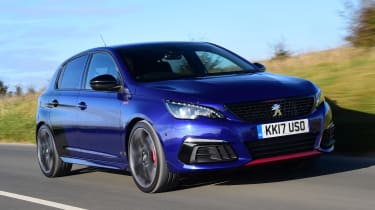
Price: £28,595Engine: 1.6-litre 4cyl, 268bhp
The 308 GTi is right on the Megane’s money. It gets a proper diff, uprated brakes and a sweet chassis. The 1.6 engine might be smaller, but it packs a punch and revs hard. The gearbox is a weak link.
SEAT Leon Cupra 300
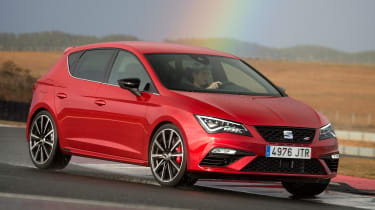
Price: £30,495Engine: 2.0-litre 4cyl, 296bhp
With a strong engine, the Leon Cupra has performance to match its rivals. It isn’t quite as engaging, plus it’s a little pricier, but it offers similar practicality. It’s available with manual or DSG transmissions, too.
Figures
| Honda Civic Type R GT | Renault Megane R.S.280 Cup Chassis | Hyundai i30 N Performance | |
| On the road price/total as tested | £33,525/£33,525 | £28,995/£34,345 | £28,010/£28,595 |
| Residual value (after 3yrs/36,000) | £13,511/40.3% | £12,001/41.4% | £12,624/45.1% |
| Depreciation | £20,014 | £16,994 | £15,386 |
| Annual tax liability std/higher rate | £2,314/£4,628 | £1,876/£3,752 | £1,811/£3,622 |
| Annual fuel cost (12k/20k miles) | £2,256/£3,759 | £2,377/£3,962 | £2,394/£3,989 |
| Insurance group/quote/road tax cost | 40/£443/£140 | 35/£534/£140 | 28/£395/£140 |
| Cost of servicing | £599 (5yrs) | £99 (3yrs) | £699 (3yrs) |
| Length/wheelbase | 4,557/2,699mm | 4,372/2,669mm | 4,335/2,650mm |
| Height/width | 1,434/1,877mm | 1,445/1,874mm | 1,447/1,795mm |
| Engine | 4cyl in-line/1,996cc | 4cyl in-line/1,798cc | 4cyl in-line/1,998cc |
| Peak power/revs | 316/6,500 bhp/rpm | 276/6,000 bhp/rpm | 271/6,000 bhp/rpm |
| Peak torque/revs | 400/2,500 Nm/rpm | 390/2,400 Nm/rpm | 378/1,750 Nm/rpm |
| Transmission | 6-speed man/fwd | 6-speed man/fwd | 6-speed man/fwd |
| Fuel tank capacity/spare wheel | 46 litres/repair kit | 50 litres/repair kit | 50 litres/space saver |
| Boot capacity (seats up/down) | 420/1,209 litres | 384/1,247 litres | 381/1,287 litres |
| Kerbweight/payload | 1,380/380kg | 1,407/498kg | 1,429/521kg |
| Turning circle | 12.6 metres | 10.3 metres | 11.6 metres |
| Basic warranty/recovery | 3yrs (60,000)/3yrs | 3yrs (60,000)/3yrs | 5yrs (unltd)/5yrs |
| Driver Power manufacturer/dealer pos. | 3rd/2nd* | 24th/27th* | 15th/12th* |
| NCAP: Adult/child/ped./assist/stars | 92/75/75/88/5 (2017) | 88/87/71/71/5 (2015) | 88/84/64/68/5 (2017) |
| 0-60/30-70mph | 5.9/4.3 secs | 6.1/5.4 secs | 6.7/5.2 secs |
| 30-50mph in 3rd/4th | 2.2/3.4 secs | 2.6/3.6 secs | 2.4/3.1 secs |
| 50-70mph in 5th/6th | 3.8/5.7 secs | 4.3/6.1 secs | 4.3/5.4 secs |
| Top speed/rpm at 70mph | 169mph/2,600rpm | 158mph/2,550rpm | 155mph/2,500rpm |
| Braking 70-0/60-0/30-0mph | 46.3/31.8/10.8m | 45.3/33.9/11.2m | 50.0/35.9/10.8m |
| Noise outside/idle/30/70mph | 69/52/66/73dB | 62/47/69/74dB | 70/53/67/73dB |
| Auto Express econ. (mpg/mpl)/range | 31.2/6.7/316 miles | 29.6/6.5/326 miles | 29.4/6.5/323 miles |
| Govt urban/extra-urban/combined | 28.8/43.5/36.7mpg | 30.1/47.1/39.8mpg | 29.1/49.6/39.8mpg |
| Govt urban/extra-urban/combined | 6.3/9.6/8.1mpl | 6.6/10.4/8.8mpl | 6.4/10.9/8.8mpl |
| Actual/claimed CO2/tax bracket | 209/176g/km/36% | 220/161g/km/33% | 222/163g/km/33% |
| Airbags/Isofix/park sensors/camera | Six/yes/yes/yes | Six/yes/yes/£400 | Six/yes/yes/yes |
| Auto box/lane keep/blind spot/AEB | No/yes/yes/yes | £1,700/£250^/£500/£400 | No/yes/no/yes |
| Climate ctrl/cruise/leather/heat seats | Yes/yes/no/no | Yes/yes/no/£1,200** | Yes/yes/part/£300** |
| Metallic/LEDs/keyless go/pwr tailgate | £525/yes/yes/no | £550/yes/yes/no | £585/yes/yes/no |
| Sat-nav/digi dash/DAB/connect apps | Yes/yes/yes/yes | Yes/yes/yes/yes | Yes/no/yes/yes |
| Wireless charge/CarPlay/Android Auto | Yes/yes/yes | No/yes/yes | Yes/yes/yes |
